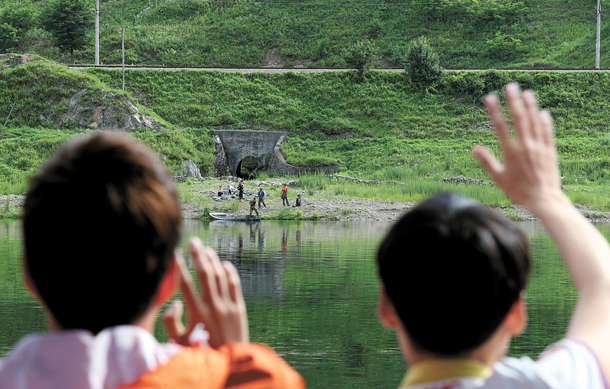Students glimpse life in North Korea

Road trip participants look into Sinuiju, North Korea, on a bridge from the Chinese side in Dandong, Liaoning Province. [KIM SANG-SEON]
The trip, which runs from July 3 to July 8, was part of the JoongAng Ilbo’s project to raise the awareness about the importance of reunification with North Korea.
The 10-week program, called “Peace Odyssey 2016,” included about 60 students who took part in the curriculum designed to provide information about the reclusive state.
As part of the final phase of the program, 23 were selected to embark on the six-day journey along the Chinese border areas spanning from Tumen to Dalian in easternmost China to see up close how North Koreans live across the border.

South Korean students wave at North Koreans across the Yalu River on a ferry from the Chinese side near the Supung Dam, located between Kuandian Manchu Autonomous County in Liaoning Province in China and Sakju County, North Pyongyang Province. [KIM SANG-SEON]
“That burnished building you see across the river is a memorial hall set up to idolize Kim Il Sung and Kim Jong-il,” said Kang Dong-wan, professor of North Korean studies at Dong-A University in Busan as he stood before the students on the moving bus.
As the students’ gaze moved to a tall tower erected at the center of a village across the river, the professor noted it was set up following the death of state founder Kim Il Sung, wishing for his eternal life.
The six-day trip included a series of encounters with North Korean towns and people, an experience that is impossible in South Korea.
The rare encounters also laid bare increased efforts by the North to block the flow of North Korean refugees seeking to escape the impoverished state in pursuit of better lives.
Along the border, a two-meter high fence was set up on the Chinese side. Across the river was an electric fence equipped with surveillance cameras.
On the final stretch of the trip, the participants saw Supung Dam located on the Yalu River between Kuandian Manchu Autonomous County in Liaoning Province in China and Sakju County, North Pyongyang Province. Constructed between 1937 and 1943, it was once the largest hydroelectric power station in Asia, providing electricity to the southern part of the peninsula before the 1950-53 Korean War.
The students got on a ferry from the Chinese side to have a closer look at the North Korean village of Sakju. When some North Koreans were seen tending to their farms, Korean students waved at them. Most of the North Koreans on the other side ignored the friendly gestures, but a couple of them rose up and waved back, a moment that struck a chord for many.
Lee Da-eun, who studies politics and internal relations at Sookmyung Women’s University, said the journey along the Chinese border with the North served to open her eyes, especially with regard to the country’s dire human rights conditions.
“The trip will provide a huge momentum for me to pursue my studies on North Korea and re-unification,” she said.
BY LEE YOUNG-JONG, SEO JAE-JOON [kang.jinkyu@joongang.co.kr]










with the Korea JoongAng Daily
To write comments, please log in to one of the accounts.
Standards Board Policy (0/250자)